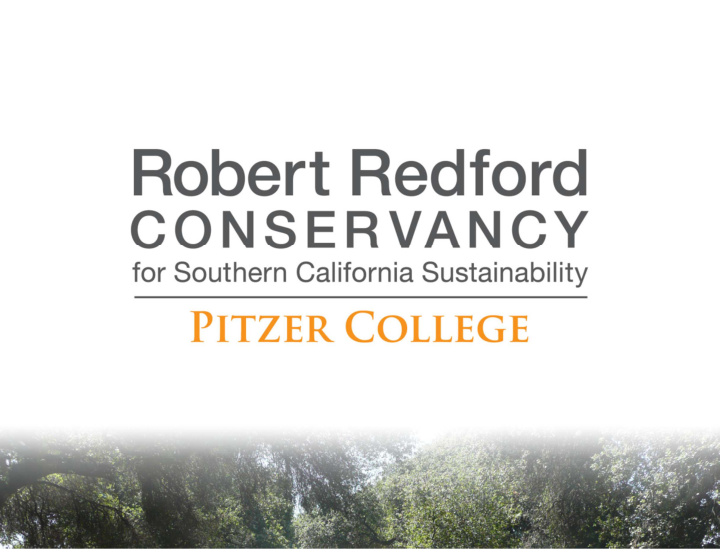



”e ngaging pe ople s and c ommunitie s for r e gional sustainability” Academically driven by the liberal arts, and guided by Pitzer College’s core values of social justice and environmental sustainability, the Redford Conservancy engages interdisciplinary and collaborative approaches to environmental problem solving. The goal of the Redford Conservancy is to promote both the longevity of Southern California’s natural environment, and the wellbeing of its peoples.
ENG A G ING PEO PL ES A ND C O MMUNIT IES FO R REG IO NA L SUST A INA BIL IT Y
PLANNI NG T HE C O NSERVANC Y Phase I September ‐ October 2015: Engaging Pitzer community with RRC • September ‐ October 2015: Weekly sessions with Planning Committee and • Carrier Johnson+CULTURE Mid ‐ November 2015: Final report of program design • Phase 1 report available on Redford Conservancy website, • http://pitweb.pitzer.edu/redfordconservancy/ Phase II December 2015: Request for bids on design and construction • January 2016: Interviews and selection of design firm • Fall 2016 ‐ Summer 2017: Renovation • Fall 2017: Redford Conservancy facility open for program •
E ndange re d sage sc rub habitat
U nde rgraduate e duc atio n and re se arc h
Public atio ns this ac ade mic ye ar 1. Hollowell, A. C., J. U. Regus, D. Turissini, K. A. Gano ‐ Cohen, R. Bantay, A. Bernardo, D. Moore, J. Pham, and J. L. Sachs. 2016. Metapopulation dominance and genomic island acquisition of Bradyrhizobium with superior catabolic capabilities. Proceedings of the Royal Society B: Biological Sciences 283: 20160496. 2. Wheeler, M. M., M. M. Dipman, T. A. Adams, A. V. Ruina, C. R. Robins, and W. M. Meyer III. 2016. Carbon and nitrogen storage in California sage scrub and non ‐ native grassland habitats. Journal of Arid Environments 129: 119 ‐ 125. 3. Thomson, D. M., R. Cruz ‐ de Hoyos, K. Cummings, and E. L. Schultz. 2016. Why are native annual abundances low in invaded grasslands? Testing the effects of competition and seed limitation. Plant Ecology 217: 431 ‐ 442. 4. Hollowell, A. C., J. U. Regus, K. A. Gano, R. Bantay, D. Centeno, J. Pham, J.Y. Lyu, D. Moore, A. Bernardo, G. Lopez, A. Patil, S. Patil, Y, Lii, and J. L. Sachs. 2016. Epidemic spread of symbiotic and non ‐ symbiotic Bradyrhizobium genotypes across California. Microbial Ecology 71: 700 ‐ 710. 5. Wu, G. C., and J. C. Wright. 2015. Exceptional thermal tolerance and water resistance in the mite Paratarsotomus macropalpis (Erythracaridae) challenge prevailing explanations of physiological limits. Journal of Insect Physiology 82: 1 ‐ 7. 6. Staubus, W. J., E. S. Boyd, T. A. Adams, D. M. Spear, M. M. Dipman and W. M. Meyer III. 2015. Ant communities in native sage scrub, non ‐ native grassland, and suburban habitats in Los Angeles County, USA: conservation implications. Journal of Insect Conservation 19: 669 ‐ 680
bfs.claremont.edu
DARTMOUTH AVE Restoration- Exterior
Original Building Photo, 1931
Aerial Site Photo, 1940’s
Current Building Front Condition
Current Building Condition
Current Building Interior Condition
Current Building Interior Condition (Fire Damage)
Existing Non-Historic Nurses’ Quarters Addition
Existing Outdoor Classroom
Foothill Blvd. Entry
Planned Exterior Building Restoration
Level 1 Floor Plan
Lower Level Floor Plan
LOWELL BLVD EXTENSION Restoration- Exterior Planned Site Plan
Restoration- Exterior
Restoration- Exterior
New Outdoor Classroom Elevations
Q + A hank you T
Recommend
More recommend